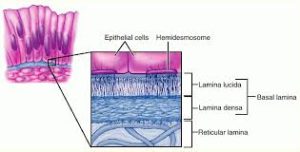 The basal lamina is a layer of extracellular matrix secreted by the epithelial cells, on which the epithelium sits.
The basal lamina is a layer of extracellular matrix secreted by the epithelial cells, on which the epithelium sits.
It is often incorrectly referred to as the basement membrane.
It is a portion of the basement membrane visualized only with the electron microscope.
It is 20–100 nm thick.
Layers of the basal lamina:
Lamina lucida, lamina densa, electron dense layers of the basal lamina typically sit on top of the reticular lamina, which is synthesized by cells from the underlying connective tissue.
When two epithelial layers abut one another as in the alveoli of the lungs and glomeruli of the kidneys, the basal lamina of one epithelial layer fuses with that of the other.
Fibrils composed of type VII collagen extend from the basal lamina into the underlying reticular lamina and loop around collagen bundles.
Although found beneath all basal laminae, they are especially numerous in stratified squamous cells of the skin.
These layers should not be confused with the lamina propria, which is found outside the basal lamina.
The term basal lamina is usually used with electron microscopy, while the term basement membrane is usually used with light microscopy.
